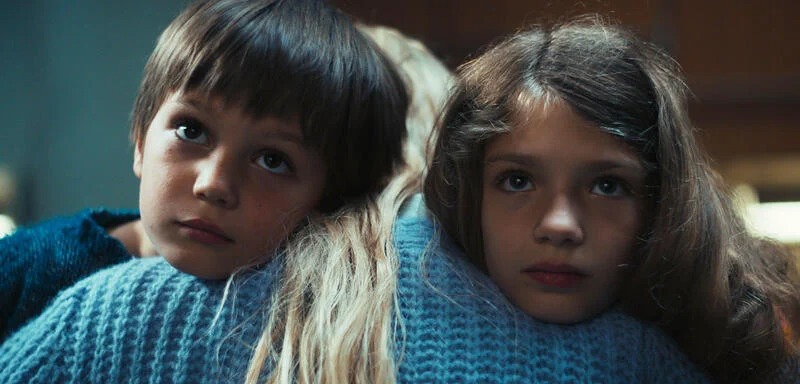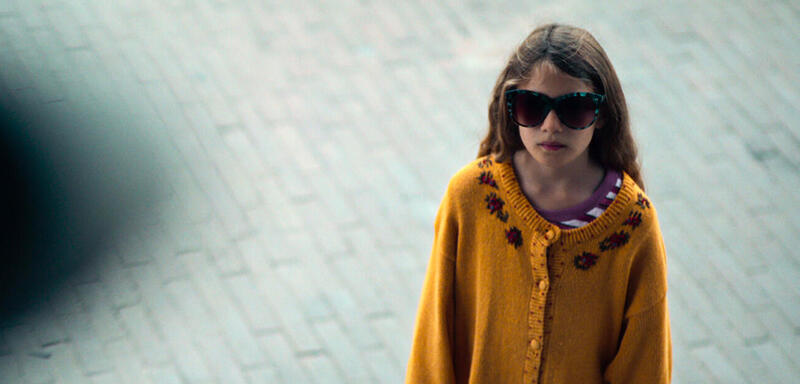The Netflix thriller Dear Child tells of kidnapping, abuse and psychological terror. In an interview, the creative duo behind the series explains how to shoot a psychological thriller with children without traumatizing them forever.
With Liebes Kind, a German series that has it all has been running on Netflix since September 7, 2023. The suspenseful thriller is an adaptation of Romy Hausmann’s bestselling novel of the same name, which made big waves when it was published in 2019. That’s because Dear Child begins where other kidnapping stories end.
A young woman (Kim Riedle) manages to escape from the captivity of a psychopath after years. With two children, she lived in a sealed-off house where she had to play at being a perfect family under strict rules. But it soon turns out: the terror is far from over – and as the series title already reveals, children play an important role in it.
What is special about the new Netflix production is not only the exciting story full of shocking twists, but also the conditions under which the 6-part miniseries was created. After all, how do you shoot a psychological thriller with such heavy subject matter without permanently traumatizing the child actors aged eight and ten?
An interview with the people responsible for Dear Child: This was especially challenging on the Netflix shoot
We checked in with the creative minds behind the series. On the occasion of the Netflix launch, Isabel Kleefeld and Julian Pörksen, who are responsible for the scripts and direction, gave us some exciting insights into the development and filming of Liebes Kind in an interview. Especially for the protection of the child stars, some creative solutions had to be found.
See the long trailer for season 1 of Dear Child on Netflix here:
Moviepilot: Was there anything from the original that was particularly tricky to implement?
Isabel Kleefeld and Julian Pörksen: Of course there are obvious hurdles in an adaptation: inner monologues and processes, thoughts and feelings have to be translated into film. But actions in themselves can also pose a problem. One example: In Romy Hausmann’s novel, there is a perpetrator who acts from the beginning, but whose identity in the book is only revealed in the last act of the novel.
In the process, Liebes Kind plays with several suspects at the same time. And if in the book it is now what ‘he’ does and how ‘he’ behaves, then this works very well in the novel form, it remains exciting and mysterious. But if you give ‘him’ a face in the series from the beginning, then the viewer sees who he is – and also who he is not. That would have let the thrill fizzle out.
What were the biggest challenges for you during the shoot?
To arrange the shooting schedule, the motif situation and the daily shooting in such a way that the legitimate guidelines for shooting with children were met. Naila Schuberth, who plays Hannah, was ten years old at the time of the shoot and Sammy Schrein, Jonathan, was only eight. At that age level, direct work time is limited to three hours with breaks that must be strictly adhered to, and on-set presence is limited to a total of 5 hours.
That alone leads to the question: what do you shoot in the other half of the day without generating too many set-ups, take-downs, motif moves and also acting days? And then of course at all: to shoot such a material with children. That’s one of the reasons why parents, a children’s coach and a media education specialist accompanied us through the preparation and the shoot. We were in constant exchange.
The young stars of the Netflix series were given children’s scripts – for an important reason

The child stars of Dear Child
You made special scripts for the child actors. Why was that necessary?
Because the genre of psychological thriller is not suitable for children of that age. We therefore came up with the idea of writing an additional, so-called “children’s script”, a parallel version that is suitable for children. We then checked this with the coach and the media education specialist before the children received “their own script. The parents had, of course, already received the actual scripts well in advance.
Is that standard when shooting dark material or rather unusual?
No idea. In any case, it turned out to be extremely helpful for us, also for the children’s play, because in the children’s script we were able to address exactly the subjective point of view and emotional attitude that Hannah and Jonathan have to the whole event, that is, their inner world.
Did the children know that they were given other scripts?
Clearly. We explained to them that there was one script version specifically for their characters and another for the adult roles, and that within the series there were sections for adults and sections for children. Just like in real life.
How did these scripts differ specifically from the “normal” scripts?
In the children’s version, the children’s dialogues and actions are embedded in a modified, age-appropriate context, but are still self-contained and logical. For example: the man who locks up his family is a psychopath and a total control freak. When he enters the room, everyone has to line up and show him their hands. In the children’s book, he’s an extremely anxious father who worries way too much about his family and wants to avoid anyone getting hurt at all costs. And on top of that, has a pronounced obsession with hygiene.
Psycho terror and murder: the stars of Dear Child are not yet allowed to watch the Netflix series

Naila Schuberth in Dear Child
Was there a scene that particularly worried you from a youth protection point of view?
For trickier scenes, we first turned everything off in the direction of the children, as it was in the children’s script. And only after the children had left the set did we shoot the shots that were still open. Of course, this requires that you react in advance with the resolution, that is, by splitting a scene into individual shots.
Furthermore, all adults who had scenes together with the children basically only worked with the children’s script version on set. Even in the daytime scheduling, the one-sentence synopses of the respective scenes were based on the children’s book. And conversations that were not intended for children’s ears were not conducted in their presence. I was surprised at how well this worked and impressed at how considerate everyone was.
What was the role of the children’s coach on set and were there moments when you were particularly happy that she was on location?
The work of the children’s coach began well before the actual shooting. In our case, she accompanied the children before, during and even after the shooting. Weeks beforehand, the two children got to know everyone involved, attended mask rehearsals to see how wounds are made, and were able to follow the construction of the house in the studio.
Then, long before shooting began, every scene in which the children were involved was rehearsed. Just like the actual filming, all always together with the really fantastic children’s coach. She also “refreshed” every scene with the kids before the actual day of shooting, and was a caring contact person for all matters during the shoot.
Apart from concrete script adaptations: How do you shoot a series about such dark topics with children without traumatizing them in the process?
By setting and explaining the topics that are reasonable for children in a child-friendly context. During the preparations, filming and also the follow-up, an extremely experienced media education specialist was present throughout, whose advice was a great help in ensuring that the entire environment was as child-friendly as possible. Among other things, she made sure that the prescribed shooting and break times were adhered to.
Even after the actual filming, there are still meetings and follow-up discussions, also so that the contact for the children does not simply break off so abruptly. Now, a year after filming and shortly before launch, we are talking to the children in more depth about the story. Also, so that the two are not suddenly confronted with comments after launch, which they could not classify or overtax. Because the two are not yet allowed to see the series, of course.

